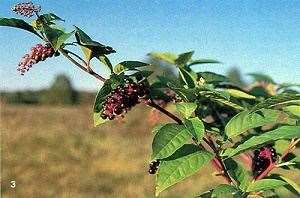Field Guide  Weed Management
Weed Management  Pokeweed
Pokeweed
Pokeweed (Phytolacca Americana)
Crop Impacts: Corn and Soybeans
 | |
About Pokeweed:Pokeweed is a native plant to North America and has entered into Britain. It is a perennial plant that is edible when cooked and can be used for medicinal purposes. Pokeweed spreads easily and interrupts the growth patterns of native plants. Family: Pokeweed Family (Phytolaccaceae)  
Pokeweed Scouting and Prevention:The best place to look for Pokeweed is in clearings, woods and along roadsides that have rich, damp soil. It can grow an astonishing 10 feet tall or higher with thin, brown bark on its stem. The leaves are smooth and alternate one another. They are approximately 2 to 3 inches wide and 5 inches long. This weed also produces flowers from July to September; they will appear in clusters with a long stock and a green center with 5 whitish petals. As the plant matures, the round berries will become a deep red or purple. Pokeweed Control:To control heavily infested grassland, plowing the soil and planting cultivated crops for a minimum of 2 years after will reduce the growth of Pokeweed. If this is not what you are looking for, then a systemic herbicide will work as well. Due to the complicated root system, the systemic herbicide is used to reach all parts of the plant, including the root system. This particular type of herbicide needs to be applied on the leaves of the plant when the plant is mature and still growing, which is in late summer. Latin / Alternative Pokeweed names:- - Phytolacca Americana
- - Common pokeweed
- - Poke root
- - Poke salad (or poke sallet)
- - Poke berry
- - Poke
- - Virginia poke
- - Inkberry
- - Cancer root
- - American nightshade
- - Pigeon berry
- - Yoshu-Yama-Gobo
- - Yyamilin
Additional Pokeweed Resources |
http://www.cancer.org/treatment/treatmentsandsideeffects/complementaryandalternativemedicine/herbsvitaminsandminerals/pokeweed
http://www.altnature.com/gallery/pokeweed.htm
http://www.omafra.gov.on.ca/english/crops/facts/ontweeds/pokeweed.htm#family
http://www.softschools.com/facts/plants/american_pokeweed_facts/1390/
http://extension.psu.edu/pests/weeds/weed-id/pokeweed